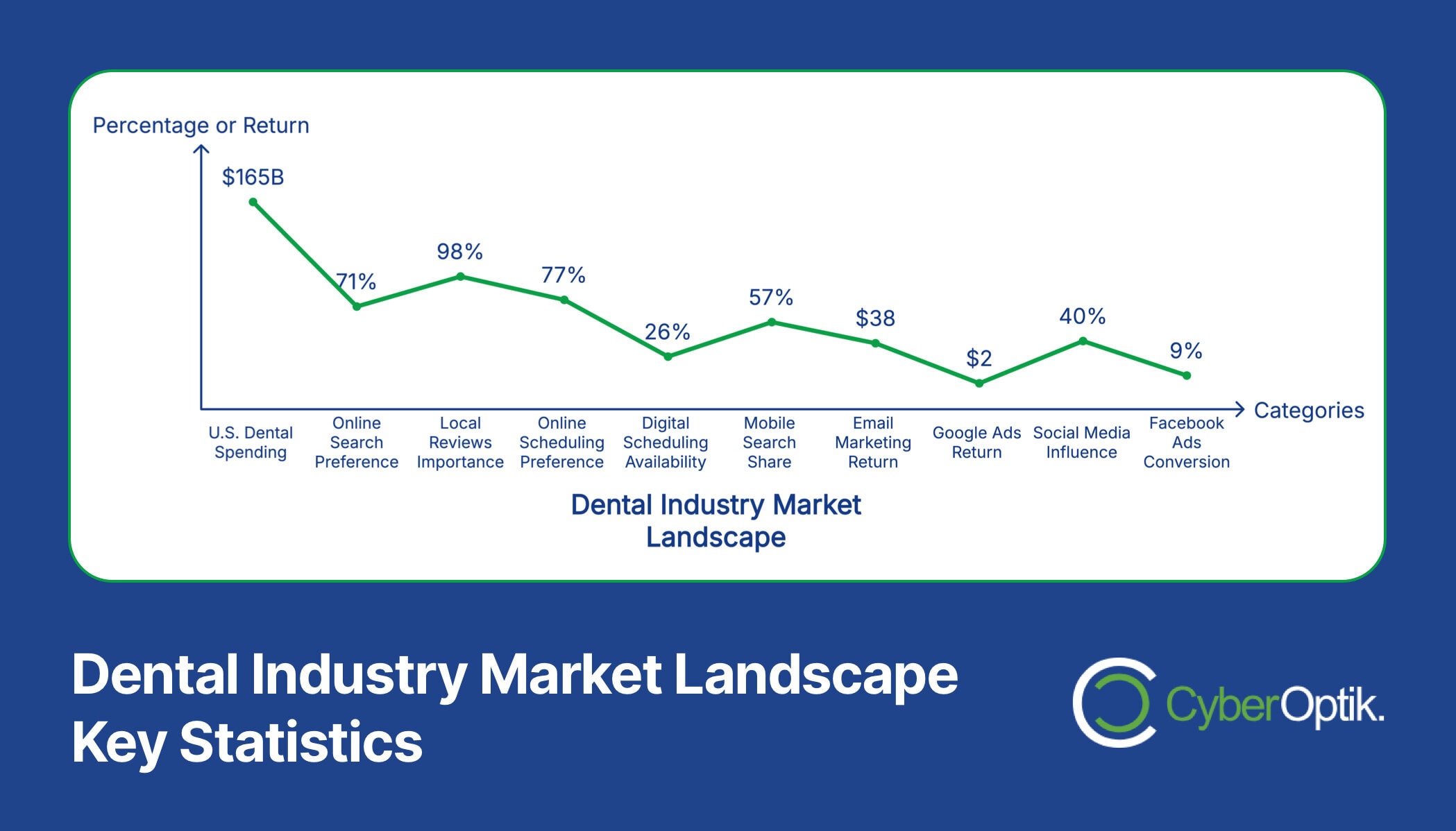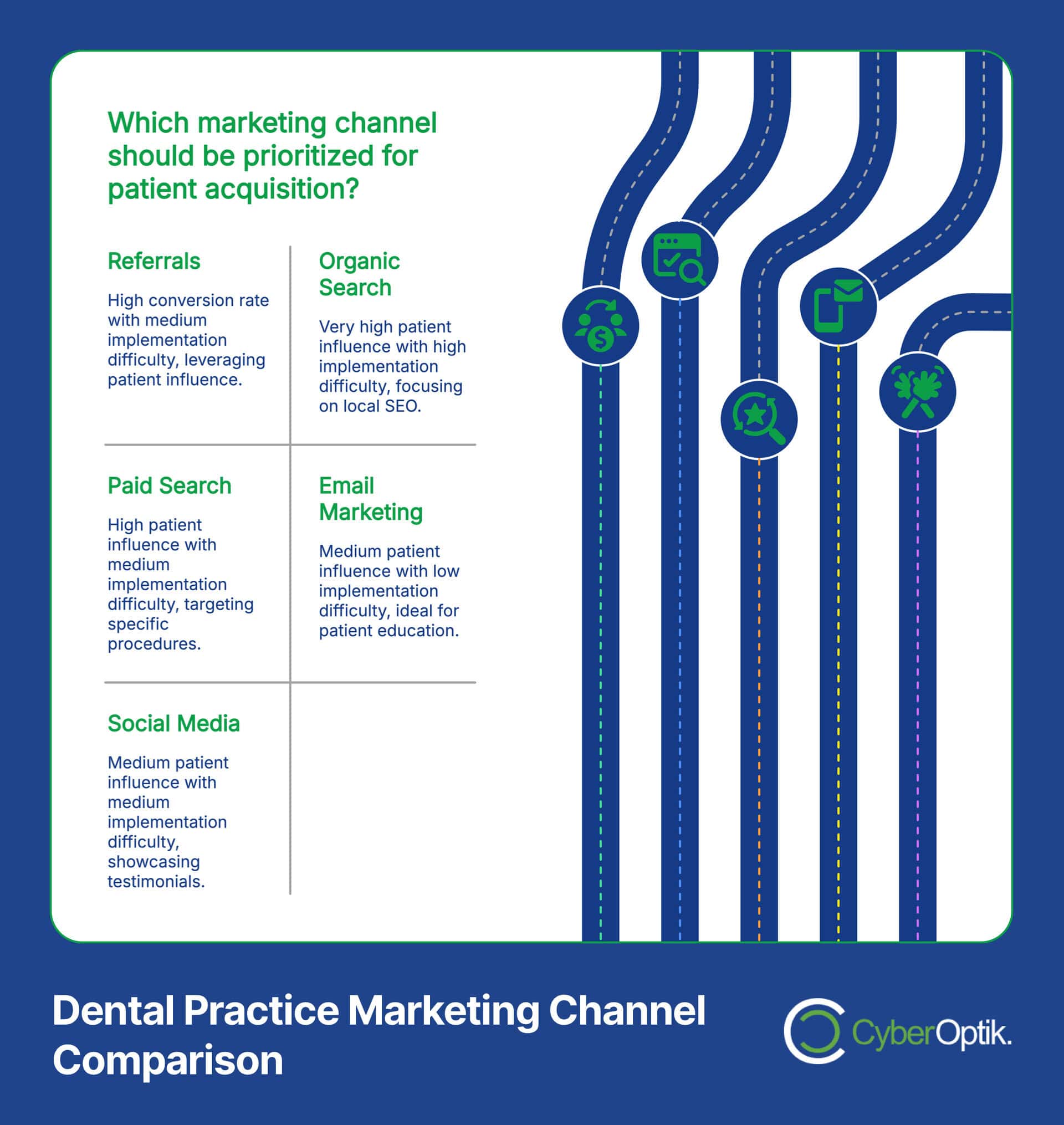Effective marketing has become essential for dental practices looking to thrive in today’s competitive healthcare landscape. With Americans spending $165 billion on dental hygiene in 2022, capturing even a small piece of this market can transform your practice. (Source: SagaPixel)
We’ve worked with numerous dental practices to develop comprehensive marketing strategies that attract new patients while strengthening relationships with existing ones. The most successful dental practices understand that marketing isn’t just about getting new patients through the door – it’s about creating a cohesive digital presence that builds trust.
This guide explores proven marketing strategies specifically tailored for dental practices. Let’s dive into actionable tactics you can implement immediately.
Understanding the Dental Marketing Industry

The dental industry faces unique marketing challenges. Trust plays a crucial role in healthcare decisions. Patients seek providers who demonstrate expertise and compassion.
Today’s dental patients conduct significant research before choosing a provider. In fact, 71% of patients search online when selecting a dentist, making digital visibility essential for practice growth. (Source: SagaPixel)
Modern dental marketing requires a multi-channel approach. The most successful practices maintain an optimized website, active social media presence, and strong local SEO strategy.
Let’s explore the current landscape of dental marketing by examining where patients come from and what influences their decisions:
| Marketing Channel | Patient Influence | Conversion Rate | Implementation Difficulty |
|---|---|---|---|
| Referrals | High | 3.74% | Medium |
| Organic Search | Very High | 2.8% | High |
| Paid Search | High | 2.5% | Medium |
| Social Media | Medium | 1.9% | Medium |
| Email Marketing | Medium | 2.3% | Low |
As the table indicates, referrals yield the highest conversion rates at 3.74%, highlighting the importance of word-of-mouth in dental marketing. (Source: NexHealth)
Patient Acquisition Strategies
Attracting new patients requires a strategic mix of digital and traditional marketing approaches. Each strategy offers unique benefits for dental practices.
Let’s examine the most effective patient acquisition channels based on current data and real-world results:
Search Engine Optimization (SEO)
SEO remains the foundation of dental practice visibility online. With 71% of potential patients searching online for dental providers, ranking well for relevant search terms is crucial. (Source: SagaPixel)
Effective dental SEO combines technical website optimization, content creation, and local search strategies. The goal is to appear prominently when potential patients search for dental services in your area.
Key components of dental SEO include:
- Local keyword targeting – Focus on terms like “dentist in [city]” or “[specialty] dentist near me”
- Google Business Profile optimization – Ensure your profile is complete with accurate business information
- Location-based content – Create content specifically addressing the needs of your local community
Local map pack visibility – Strategic efforts to appear in Google’s local three-pack of map results

Pay-Per-Click (PPC) Advertising
Paid search offers immediate visibility for dental practices while organic SEO efforts develop. Paid search currently drives 35% of total dental website traffic, making it a significant channel for new patient acquisition. (Source: NexHealth)
Most dental practices invest substantially in PPC, with practices spending approximately $5,000 per month on average for campaigns. This investment typically pays off, as Google Ads returns $2 for every $1 spent. (Source: Workforce Dental Staffing)
We’ve found that well-structured PPC campaigns targeting specific dental procedures (like implants, Invisalign, or emergency services) typically yield the best returns. Geographic targeting ensures ad spend reaches only potential patients in your service area.
Social Media Marketing
Social media platforms offer dental practices opportunities to showcase their expertise, build community relationships, and humanize their practice. Currently, 40% of patients use social media to guide their dental decisions. (Source: Workforce Dental Staffing)
Facebook provides particularly strong results for dental practices, with an ad conversion rate of 9%, higher than many other channels. (Source: Great Dental Websites)
Effective social media content for dental practices includes:
- Patient testimonials and success stories (with proper consent)
- Educational content about dental procedures and oral health
- Team highlights that showcase the human side of your practice
- Community involvement and charitable initiatives
- Limited-time promotions for specific services
Referral Marketing
Patient referrals remain the highest-converting source of new patients with a 3.74% conversion rate. A strategic referral program can systematically grow your practice through word-of-mouth. (Source: NexHealth)
Successful referral programs make it easy for satisfied patients to recommend your practice while offering incentives that benefit both parties. Simple discount structures or small gifts can significantly increase referral rates.
| Referral Program Type | Implementation | Typical Conversion Rate | Cost Effectiveness |
|---|---|---|---|
| Direct Patient Incentives | Offer discounts/credits to referring patients | High | High |
| Dual Incentives | Rewards for both referrer and new patient | Very High | Medium |
| Community Partnerships | Cross-referrals with complementary businesses | Medium | High |
| Professional Referrals | Relationships with other healthcare providers | Medium-High | Medium |
The table above outlines different referral strategies and their typical outcomes. Dual incentive programs, where both the referrer and the new patient receive benefits, typically generate the highest conversion rates.
Email Marketing
Email marketing delivers exceptional ROI for dental practices. With an average return of $38 for every $1 spent, email marketing offers one of the most cost-effective channels for patient acquisition and retention. (Source: Great Dental Websites)
Strategic email campaigns can help fill appointment gaps, promote specific services, and maintain relationships with patients between visits. Patient education emails also position your practice as a trusted authority in dental health.
Patient Retention Strategies
Acquiring new patients is important, but retaining existing ones proves more cost-effective. Effective retention strategies keep patients coming back while encouraging referrals.
Let’s explore the most successful approaches to patient retention in today’s digital environment:
Patient Experience Optimization
A seamless patient experience from first contact through treatment and follow-up creates loyalty. Modern patients expect convenience, clear communication, and personalized care.
Digital tools can significantly enhance the patient experience. Currently, 49% of practices use automated appointment reminders to reduce no-shows and improve scheduling efficiency. (Source: NexHealth)
The most successful dental practices create patient journeys that minimize friction at every touchpoint – from appointment scheduling to payment processing.
Review Management
Online reviews significantly impact dental practice reputation and patient acquisition. An overwhelming 98% of patients read local reviews before choosing a dentist, making review management essential. (Source: Workforce Dental Staffing)
Implementing a systematic approach to gathering positive reviews from satisfied patients creates social proof that attracts new patients while reinforcing loyalty among existing ones.
Respond professionally to all reviews – positive and negative. Thoughtful responses to criticism demonstrate your commitment to patient satisfaction and can often turn negative experiences into positive outcomes.
Digital Communication
Modern patients expect convenient communication options. Texting, email, and patient portals have become standard expectations rather than premium features.
Consistent, relevant communication between appointments helps maintain patient engagement with your practice. Educational content, preventive care reminders, and celebration of personal milestones (birthdays, anniversaries) strengthen the patient-practice relationship.
| Communication Channel | Best Use Case | Response Time Expectation | Patient Preference Level |
|---|---|---|---|
| Text Messaging | Appointment reminders, quick questions | Within 1 hour | Very High |
| Detailed information, forms, education | Within 24 hours | High | |
| Patient Portal | Records access, bill payment, scheduling | Self-service | Medium-High |
| Phone | Complex questions, emergency issues | Immediate | Medium |
| Social Media | General inquiries, community building | Within 24 hours | Low-Medium |
The table above shows how different communication channels serve different purposes in patient relationships. Implementing a multi-channel approach addresses varied patient preferences.
Online Scheduling
Despite 77% of patients preferring online scheduling, only 26% of dental practices currently offer this feature. This gap represents a significant opportunity to differentiate your practice. (Source: Sixth City Marketing)
Online scheduling increases convenience for patients while reducing administrative workload for your team. Modern scheduling systems can integrate with your practice management software to prevent double-booking and ensure proper appointment lengths for different procedures.
Optimizing Your Dental Practice Website
Your website serves as the digital front door to your practice. An optimized site converts visitors into patients while supporting your broader marketing efforts.
Let’s examine the most important elements of an effective dental practice website:
Mobile Optimization
With 57% of local dental searches coming from mobile devices, mobile optimization is no longer optional. A responsive, fast-loading website provides a seamless experience across all devices. (Source: Workforce Dental Staffing)
Mobile optimization goes beyond responsive design. Loading speed, easy navigation, and click-to-call functionality significantly impact conversion rates on mobile devices.
Content Strategy
Educational content establishes your practice as an authority while attracting organic search traffic. Websites with blogs have 434% more indexed pages, dramatically increasing discovery opportunities. (Source: Great Dental Websites)
Effective dental content addresses common patient questions, explains procedures in patient-friendly language, and offers preventive care guidance. Service pages should clearly communicate benefits, procedures, and expected outcomes.
Common website content issues that drive potential patients away include:
- Outdated design that diminishes credibility
- Slow page loading (especially on mobile devices)
- Difficult navigation that frustrates users
- Missing or hard-to-find contact information
- Lack of clear information about services offered
Local SEO
Local search optimization directly impacts practice visibility when potential patients search for dental services nearby. Local SEO strategies require consistent NAP (Name, Address, Phone) information across all online platforms.
Google Business Profile optimization plays a crucial role in local visibility. Complete profiles with recent photos, accurate business hours, and regular posts appear more prominently in local search results.
| Website Element | Optimization Priority | Impact on Conversions | Implementation Difficulty |
|---|---|---|---|
| Clear Call-to-Action | Very High | Very High | Low |
| Online Scheduling | High | High | Medium |
| Mobile Responsiveness | Very High | High | Medium |
| Page Loading Speed | High | High | Medium-High |
| Service Pages | High | Medium-High | Medium |
| Patient Testimonials | Medium-High | High | Low |
| Doctor/Team Profiles | Medium | Medium | Low |
This table outlines key website elements and their impact on patient conversion. Note that clear calls-to-action and online scheduling options deliver the highest conversion impact relative to implementation difficulty.
Measuring Marketing Success
Effective dental marketing requires consistent measurement and optimization. Tracking key performance indicators helps identify what’s working and where adjustments are needed.
Let’s explore the most important metrics for evaluating dental marketing efforts:
Key Performance Indicators
Monitor these essential metrics to gauge marketing effectiveness:
| Marketing Metric | What It Measures | Target Benchmark | Measurement Frequency |
|---|---|---|---|
| New Patient Acquisition Cost | Cost to acquire each new patient | $150-300 | Monthly |
| Website Conversion Rate | Visitors who schedule appointments | 3-5% | Weekly |
| Patient Lifetime Value | Total revenue from average patient | $2,000-10,000 | Quarterly |
| Treatment Acceptance Rate | Proposed treatments accepted | 70-85% | Monthly |
| Patient Retention Rate | Patients returning for care | 85-95% | Quarterly |
| Google Ranking Position | Search result position for key terms | Top 3 results | Monthly |
The metrics above provide a comprehensive view of marketing performance across the patient journey from acquisition through retention. Regular review helps identify trends and opportunities for improvement.
ROI Evaluation
Marketing ROI calculation helps prioritize investments across channels. Different marketing strategies deliver varying returns:
- Email marketing: $38 return per $1 spent
- Google Ads: $2 return per $1 spent
- Referral programs: Varies by implementation but typically 5-10x return
- SEO: Long-term investment with 5-12x return over time
- Social media: Direct ROI challenging to measure but supports other channels
The most successful dental practices don’t view marketing channels in isolation. Instead, they recognize how each element of their marketing strategy supports others in a cohesive ecosystem.
Effective dental marketing combines digital strategies with exceptional patient experience to attract and retain patients. The practices that thrive implement comprehensive approaches rather than isolated tactics.
We’ve observed that the most successful dental practices prioritize these core elements:
First, they build strong digital foundations with optimized websites and local SEO. Second, they implement multi-channel patient acquisition strategies including referrals, SEO, and targeted advertising. Third, they focus on patient retention through excellent communication and streamlined experiences.
Finally, they measure results consistently and adjust strategies based on data. This cycle of implementation, measurement, and refinement drives continuous improvement.
Ready to transform your dental practice marketing? Consider a comprehensive marketing audit to identify your biggest opportunities for growth. The right strategy combines proven best practices with approaches tailored to your unique practice position and patient base.




